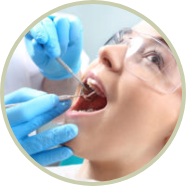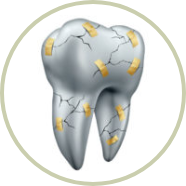
Moderate sedation is an altered state of consciousness, where you become disassociated with your surroundings. Memory, anxiety levels and perception of pain are greatly reduced, and you should become very relaxed and comfortable. Most people having moderate sedation “think” they have been asleep because they may not remember anything that went on from the time the sedation started to the time they left the office.

Nitrous Oxide is a non-irritating, colorless gas which you can breathe. Nitrous Oxide (laughing gas) has been a primary means of sedation in dentistry for many years. It produces mild euphoria and amnesia. It has a calming effect on mildly anxious patients. Administered as a inhalant, along with oxygen, it is safe and it leaves little or no “hangover.

Oral sedation dentistry is a medical procedure involving the administration of oral sedative drugs, generally to facilitate a dental procedure and reduce patients fear and anxiety related to the experience. Oral sedation is one of the available methods of conscious sedation dentistry, along with inhalation sedation (nitrous oxide) and conscious intravenous sedation.
Uses for CBCT Imaging
The CBCT scanner allows us to see things a traditional X-ray cannot show. It can be used to diagnose, and create treatment plans for, a variety of different oral health issues:
Benefits of CBCT Imaging
CBCT imaging provides a number of different benefits:

INITIAL CONSULTATION
Dr. MacDonald has had the training and experience at diagnosing the source of dental pain. He will be able to differentiate between pain caused by your tooth and other facial pain. Sometimes an initial consultation visit is required to gather necessary information and to answer some questions.

NONSURGICAL ROOT CANAL RETREATMENT
There are some root canals that can become reinfected and do not heal properly. By retreating the root canal, it gives the tooth a second chance for healing. Some reasons why a root canal fails to heal are: Decay or leakage under a crown or filling; Narrow or curved canals; Breakdown of the original root canal seal.

TOOTH AVULSION/TRAUMA
The management of dental trauma varies between children with developing teeth (“baby” teeth, deciduous or primary teeth) and adults with permanent teeth. While all dentists are trained to take care of dental trauma, a specialist dentist, called an endodontist is further trained for an additional two years after dental school to take care of injuries inside the tooth.

ROOT CANAL TREATMENT
A hole is made in the side or top of the tooth, and the interior pulp and nerve tissue of the tooth is removed, down to the tip of each root. The newly cleaned interior of the tooth is filled with an inert material to seal it, and a filling is placed over the tooth. If a temporary filling is placed another appointment is needed with your regular dentist, in which a permanent filling or crown is placed over the tooth.

APICOECTOMY
Surgical Root Canal Therapy, also known as an apicoectomy, is performed when non surgical root canal therapy was unsuccessful. An Apicoectomy is done under local anesthesia. Dr. MacDonald will retract the gum tissue near the tooth, and any inflamed or infected tissue that is around the tip of the root is removed. Once the tissue is cleaned out the root is shortened and a small filling is placed in the end of the canal. A few stitches are used to help hold the gum in place.

CRACKED TEETH
Endodontists specialize in saving cracked teeth and will cater treatment to the type, location, and extent of the crack. The sooner your tooth is treated, the better the outcome. Once treated, most cracked teeth continue to function as they should, for many years of pain-free biting and chewing.

840-2025 Willingdon Ave
Burnaby, BC V5C 0J3
Phone: 604-299-1661
Fax: 604-299-1671
